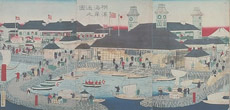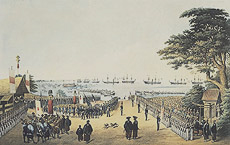Hokkaido Toyako Summit
Venues

According to documentary and other evidence, the origins of Yokohama date back to the eleventh century, but the name first entered the history books only in 1854 as the place where the U.S.-Japan Treaty of Amity was signed.
Under the Ansei Treaties of 1858 with the U.S., Holland, Russia, Britain, and France, Yokohama became the ports to be opened to international trade from the following year.
After the opening of the Port of Yokohama on July 1, 1859 (June 2 under the old calendar), the flow of overseas culture and technology began to arrive in Yokohama, from where it spread across the country. In this way, Yokohama served as an engine for propelling Japan into the modern age as "the point of origin of Japan's modernization."

Commodore Perry's landing at Yokohama
After that, following the catastrophic damage caused by the Great Kanto Earthquake of 1923 and the destruction of some 42% of the city in the massive air raids during the Second World War, and delay of infrastructure by requisition in postwar days, Yokohama has been rebuilt developed as Japan's most representative international port city.
The Point of Origin of Japan's Modernization, Yokohama's Footsteps Over 150 Years
| 1859 | Port of Yokohama opens |
|---|---|
| 1860 | Clinic for treating Japanese patients opens (Hepburn, U.S.) |
| 1869 | Telegram transmission demonstrated (Gilbert, U.K.) |
| 1872 | Railway opens between Shinbashi (present Shiodome) and Yokohama (present Sakuragi-cho) (Morell, U.K.); gas lighting starts (Pelegrin, France) |
| 1887 | Modern water service starts (Palmer, U.K.) |
| Meiji Constitution drawn up based on Prussian Constitution | |
| 1889 | Yokohama officially registered as a city |
| 1956 | Transfer to Government-designated city status |
| 2002 | Yokohama hosts FIFA World Cup Final game, etc. |
| 2008 | Fourth Tokyo International Conference on African Development held in Yokohama |
| 2009 | 150th anniversary of the opening of the Port of Yokohama |